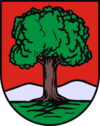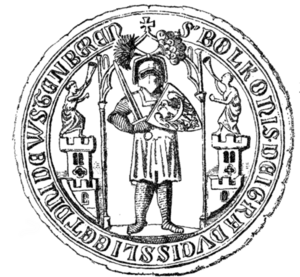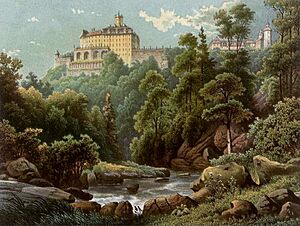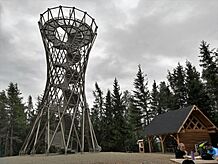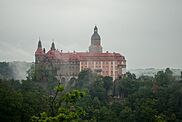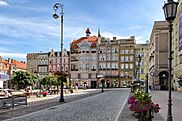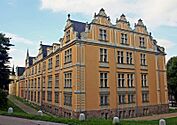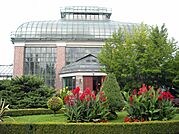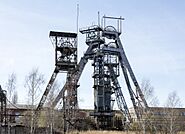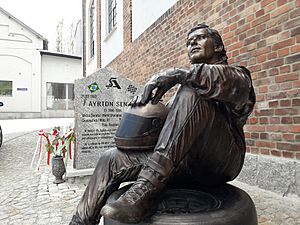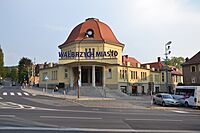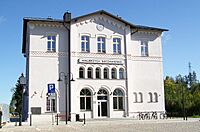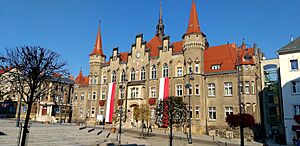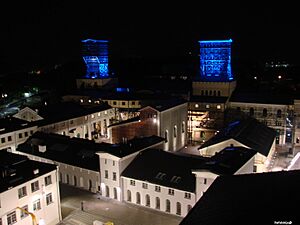Wałbrzych facts for kids
Quick facts for kids
Wałbrzych
|
|||
|---|---|---|---|
|
|||
|
|||
| Country | |||
| Voivodeship | |||
| County | city county | ||
| Established | 9th century | ||
| City rights | 1400 to 1426 | ||
| Area | |||
| • Total | 84.70 km2 (32.70 sq mi) | ||
| Elevation | 350 m (1,150 ft) | ||
| Population | |||
| • Total | 108,222 |
||
| Time zone | UTC+1 (CET) | ||
| • Summer (DST) | UTC+2 (CEST) | ||
| Postal code |
58-300 to 58-309, 58-316
|
||
| Area code(s) | +48 74 | ||
| Car number plates | DB, DBA | ||
Wałbrzych is a city in southwestern Poland. It is located in the Lower Silesian Voivodeship. The city is about 70 kilometers (43 miles) southwest of Wrocław, which is the capital of the region. It is also close to the Czech border.
Wałbrzych covers an area of about 85 square kilometers (33 square miles). It has around 110,000 people living there. This makes it the second-largest city in its region. It is also the 33rd largest city in Poland.
Long ago, Wałbrzych was a big center for coal mining and other industries. The city was not damaged during World War II. Because of this, it still has many old and beautiful buildings. One of its most famous landmarks is Książ Castle. This is the largest castle in Lower Silesia. It is also the third-largest castle in all of Poland.
In 2015, Wałbrzych became well-known around the world. People were searching for a Nazi gold train that was supposedly buried there. However, the train was never found.
Contents
What's in a Name?
The city's official website says its oldest Polish name was Lasogród. This name means 'forest castle'. The German name for the city is Waldenburg. This also means 'forest castle'. It referred to the Nowy Dwór castle, whose ruins are south of the city. This German name started to be used for the whole settlement in the 15th century. The modern Polish name, Wałbrzych, comes from the German name Walbrich. This was a later version of older names like Wallenberg or Walmberg.
A Look at History
| Historical population | ||
|---|---|---|
| Year | Pop. | ±% |
| 1950 | 93,842 | — |
| 1960 | 117,209 | +24.9% |
| 1970 | 125,200 | +6.8% |
| 1980 | 133,549 | +6.7% |
| 1990 | 141,011 | +5.6% |
| 2000 | 131,675 | −6.6% |
| 2010 | 120,197 | −8.7% |
| 2020 | 109,971 | −8.5% |
| source | ||
Early Beginnings
Some Polish stories say that Wałbrzych started as an old Slavic village called Lasogród. People there hunted, gathered honey, and farmed. This village grew into a fort. The remains of this fort were later destroyed in the 1800s as the city grew. However, some German historians say there is no proof of a Slavic village or a castle before the late 1200s.
In April 2022, a collection of old coins was found near Wałbrzych. These coins were from the early 1200s. This shows that people lived in the area a long time ago.
Some historians believe Wałbrzych was a small village by 1191. Others say the city was founded between 1290 and 1293. It was first called Waldenberc in 1305. The city was built near Nowy Dwór castle. Duke Bolko I the Strict of the Piast dynasty built this castle. The region became part of Poland in the 900s. Over time, it was part of different Polish-ruled areas.
The settlement was first called a town in 1426. But it did not get special rights like holding markets. This was because of other towns nearby. The city later belonged to knightly families. These included the Schaffgotsches and the Czettritzes. From 1738, the Hochberg family owned it. They also owned Książ Castle.
Modern Times
People started mining coal in the area around 1536. Wałbrzych became an industrial city in the late 1700s. Coal mining and weaving became very important.
In 1742, the city became part of the Kingdom of Prussia. Later, in 1871, it became part of Germany. In 1843, Wałbrzych got its first train connection. This linked it to Breslau (now Wrocław, Poland). In the early 1900s, a glass factory and a large china tableware factory were built. These factories are still working today.
During World War II, the city was taken by the Soviet Red Army on May 8, 1945. This was the day World War II ended in Europe.
After World War II, Wałbrzych became part of Poland again. This happened because of new borders set at the Potsdam Conference. Many Germans living in the city moved away. Poles from other parts of Poland moved to Wałbrzych. These included Poles who had to leave their homes in eastern Poland. Some Poles also came back from France, Belgium, and Germany. A few Germans stayed because their skills were needed for the economy, like in coal mining. Some Greeks also settled in Wałbrzych in the 1950s. They were refugees from the Greek Civil War.
The city was not badly damaged during World War II. It grew by adding nearby areas and building new homes. From 1975 to 1998, it was the capital of the Wałbrzych Voivodeship. In the early 1990s, the city's coal mines were closed. In 1995, a Museum of Industry and Technology was opened. It is located in the oldest coal mine in the area.
City's Location and Nature
Wałbrzych is in the middle of the Sudeten Mountains. It is close to the borders of the Czech Republic and Germany. The city is by the Pełcznica River. It sits in a valley at about 450–500 meters (1,476–1,640 feet) above sea level. Around the city are wooded mountains.
The highest point in the city is Mount Borowa. It is also called the Black Mountain. It is 853 meters (2,798 feet) above sea level. There has been an observation tower there since 2007. This is the highest peak in the Wałbrzych mountains.
Wałbrzych has seven city parks. In the main city park, King Jan III Sobieski Park, there is a special mountain shelter. It is called PTTK Harcówka. This is the only mountain shelter in Poland located in a city center.
Protecting Nature
Wałbrzych has several Protected areas:
- Książ Landscape Park is on the northern edge of the city.
- Przełomy pod Książem Nature reserve is also on the northern edge.
- Sudety Wałbrzyskie Landscape Park is on the southern edge.
- Chełmiec Mountain Natura 2000 area is on the western edge.
The city also has several natural monuments. One is the coat of arms oak. This tree is a descendant of the oak that inspired the city's coat of arms. A stone nearby says, "City oak planted in 1933 in place of the coat of arms oak."
Places to See
- Książ Castle: This is the biggest castle in Silesia. It is the third-largest castle in Poland. Only Wawel Castle in Kraków and Malbork Castle are bigger.
- Old Książ Castle: These are Gothic ruins. They are located across a valley from Książ Castle.
- Nowy Dwór Castle: The ruins of this castle are on top of Castle Hill.
- Czettritz Castle (built 1604–1628): This old castle is now the Angelus Silesius State College.
- Sanctuary of Our Lady of Sorrows: This Gothic church was rebuilt in a Baroque style. It is the oldest building in Wałbrzych. People call it "the heart of the city."
- Town Hall (Ratusz): This is a grand, three-story building. It looks like a mix of historical styles, including Gothic.
- Palmiarnia (Palm House): A special place with many different kinds of palm trees and other plants.
- Market Square (renovated 1997–1999): In the past, a weekly market was held here.
- Museum of Porcelain: This museum is in the old Alberti Palace.
- Guardian Angels Church: Built in 1898 in a neo-Gothic style.
- Protestant Church: Designed between 1785 and 1788 by Carl Gotthard Langhans. He also designed the Berlin Brandenburg Gate.
- Railway tunnel under the Little Wołowiec mountain: This tunnel is 1,601 meters (5,253 feet) long. It is the longest railway tunnel in Poland.
- Mountain Borowa (Black Mountain): The highest mountain in the Wałbrzyskie Mountains. It has an observation tower.
- Mountain Chełmiec: The second-largest peak in the area. It is a huge, dome-shaped mountain that stands over the city. At the top, there is an observation tower, a 45-meter cross, and two radio-television masts.
- Old Mine – Center for Science and the Arts: This is the biggest tourist spot in Poland that used to be an industrial site. It is in the old "Julia" coal mine. You can see old mining equipment there.
- Mining and Motorsports Museum: Located on Ayrton Senna street.
- Ayrton Senna's statue: A statue of the famous race car driver, located next to the Mining and Motorsports Museum.
Getting Around Wałbrzych
Roads
Wałbrzych is connected by several important roads. ![]() National Road 35 connects the city to the A4 highway and the Czech border. There are also several regional roads:
National Road 35 connects the city to the A4 highway and the Czech border. There are also several regional roads: ![]() 367,
367, ![]() 376,
376, ![]() 379, and
379, and ![]() 381.
381.
Public Transportation
The city has 14 bus lines to help people travel around.
Railway
Wałbrzych has two main train routes for passengers:
- Wrocław - Wałbrzych - Jelenia Góra (Line No. 274)
- Wałbrzych - Kłodzko (Line No. 286)
There are several train stations in the city: Wałbrzych Miasto, Wałbrzych Fabryczny, Wałbrzych Szczawienko, Wałbrzych Centrum, and Wałbrzych Główny. From Wałbrzych Główny, you can take weekend trains to Meziměstí and Adršpach-Teplice Rocks from May to September.
Aviation
The closest airport is Copernicus Airport Wrocław. It is about 70 kilometers (43 miles) from Wałbrzych. There is also a small landing strip for light aircraft about 10 kilometers (6 miles) away in Świebodzice.
City Areas
Wałbrzych is made up of several districts. Here are some of them, with the year they became part of the city:
- Nowe Miasto (1880)
- Stary Zdrój (1905, 1919)
- Poniatów (1929, 1973)
- Podgórze I (1931)
- Podgórze II (1934)
- Sobięcin (1951)
- Szczawienko (1951)
- Rusinowa (1951)
- Piaskowa Góra (1951)
- Biały Kamień (1951)
- Konradów (1958)
- Kozice (1958)
- Glinik Stary (1973)
- Książ (1973)
- Lubiechów (1973)
- Glinik Nowy (1973)
- Podzamcze (1976)
- Osiedle Wanda
Learning in Wałbrzych
Wałbrzych has several places for education:
- Angelus Silesius State University in Wałbrzych
- Wrocław Technical University in Wałbrzych
- Wałbrzyska Wyższa Szkoła Zarządzania i Przedsiębiorczości
- Ignacy Paderewski High School
- Hugo Kołłątaj High School
- Mikołaj Kopernik High School
The city also has a research center from the Polish Academy of Sciences.
Sports Teams
Wałbrzych is home to several sports clubs:
- Górnik Wałbrzych is a professional men's basketball club. They have won the Polish championship two times.
- Górnik Wałbrzych is a professional men's football (soccer) club. They played in Poland's top league in the 1980s.
- Zagłębie Wałbrzych has both male and female football clubs. The men's team played in the top league in the 1960s and 1970s. They even reached the 1/16 finals in the UEFA Cup.
- KK Wałbrzych is a semi-professional men's basketball club.
- Chełmiec Wałbrzych is a professional men's and women's volleyball team.
There are also many other football and basketball clubs in the city. LKKS Górnik Wałbrzych is a cycling club. Sebastian Janikowski, a famous American football player, was born in Wałbrzych.
Sister Cities
Wałbrzych is connected with other cities around the world. These are called twin towns or sister cities:
 Boryslav, Ukraine (since 2009)
Boryslav, Ukraine (since 2009) Cape Breton, Canada (since 2019)
Cape Breton, Canada (since 2019) Dnipro, Ukraine (since 2001)
Dnipro, Ukraine (since 2001) Foggia, Italy (since 1998)
Foggia, Italy (since 1998) Freiberg, Germany (since 1991)
Freiberg, Germany (since 1991) Gżira, Malta (since 2000)
Gżira, Malta (since 2000) Hradec Králové, Czech Republic (since 1991)
Hradec Králové, Czech Republic (since 1991) Jastarnia, Poland (since 1997)
Jastarnia, Poland (since 1997) Vannes, France (since 2001)
Vannes, France (since 2001)
Images for kids
See also
 In Spanish: Wałbrzych para niños
In Spanish: Wałbrzych para niños








